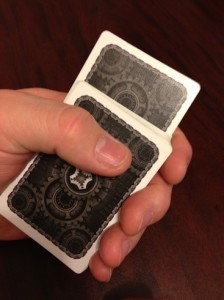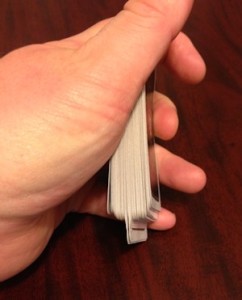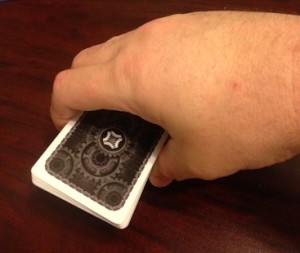Plunger Control
For you oldies-but-goodies out there, you may be familiar with ye olde plunger principle. If you’re not, try this fun little experiment. Go grab your trusty deck of Bikes. Then place a card protruding from the front of the deck about in the middle (figure below).
While holding in the left hand as shown above, use your right hand fingers to tap the card into front of the deck. If you give it a decent (i.e., somewhat hard) tap, you’ll find that a few cards will poke out the back of the pack as in the photo below.
You’ll find that if you use your right thumb and push the card(s) that are now protruding from the back (see above) back into the deck, the original card you placed in the deck will be back in the same position it started in as shown in the first photo. That’s the basic idea.
Plunger Exercises
Using this technique, you can very easily create the illusion that you’ve very fairly placed a selected card in the center of the deck, when in reality you’ve maintained control of the card. But before we get there, I want you to get used to the feel of the plunger. So start over. Go back to the first illustration. Hold the deck a little (but not too much) firmer than you normally do in dealer’s grip.
Place the card in the front as before. Then push the card in as before, and the cards will protrude from the back as in the second photo again. Then while keeping the slightly tighter grip on the deck, push the cards flush from the back with your right thumb. Again, they selected card will protrude from the front after this action. Then push it flush again with your finger tips. Then back again with your thumb . . . back and forth, back and forth.
You’ll find that with each “plunge” the cards will protrude less and less until they no longer protrude. When you get to that point, just out jog another card and start over. Again, this is just a practice exercise for the real work to come.
The Real Work Cometh
Now that you’ve officially warmed up your plunger fingers, here’s the control method. Start as normal . . . show the selected card around, and place it in the deck sticking out as before . . . tilt your left hand up one last time to show the card around to the audience. Then lower it back to standard dealing grip and push the card flush letting the cards poke out the back as they will.
Then push the rear cards back in with the thumb per the usual handling outlined above. However, this time as the card is forced back to the “protruding from the front” position, you don’t want the audience to see that it’s sticking out again. Thus, your right fingers will cover the front of the cards much like you might if you were about to execute a two-handed top palm.
Next, your right fingers will grasp the deck on the left front side of the pack while your right thumb comes around and grabs the deck on the front right side. The image below shows this position. However, keep in mind that the left hand is removed for clarity (and because I needed it to take the picture). Also, what you don’t see is that there is a card protruding from the front of the deck hidden by my right hand.
From this position (above), merely rotate the deck so that the protruding card is toward you and table the deck. From the audience’s perspective, the cards are flush from the front, but they don’t realize that there is a card sticking out the back of the deck. The card should only be sticking out about the width of the white border on the back of the cards. Anything more than that is too much, so practice the feel of this.
Once there, you’re free to talk and gesture hands free all the while a secret break is being kept in the deck. When you pick up the deck, you can either push down on the jogged card with your right thumb or you can pull up on the card with the right thumb. Pulling up allows you to get a thumb break beneath the card; pushing down gets the break above it. Now you’re positioned for a double undercut, classic pass, whatever . . . you’re in control.
Plunger Pointers
This is a very casual thing. It should look as though you placed the card in the deck and just “tapped it home” and put the deck down, nothing more. An added convincer is to look away to your right as you do this move. Then set the deck down on the table, and only then look back at the audience. This makes everyone less likely to look at the deck. After all, you’re just putting the card back in the deck.
Keep in mind that this does have some angle restrictions. The right side is particularly vulnerable because you’ll notice that you’ll tend to put the deck down sort of at an angle rather than perfectly straight. So the majority of the deck is protected on the left side but not so much on the right side. This is a super easy and natural feeling card control. Below is an over the shoulder exposed, slowed down exaggerated demonstration of the move. Remember that in performance, you’d have a smaller break and you’re right fingers would provide better cover. Enjoy the clip.



